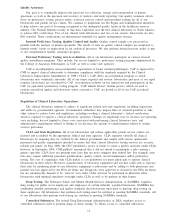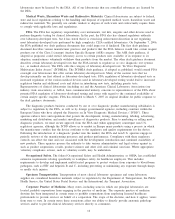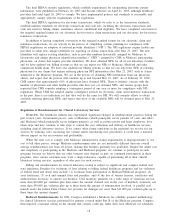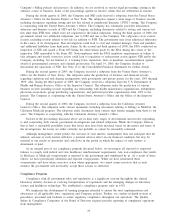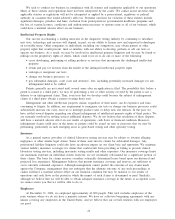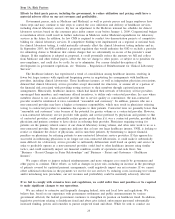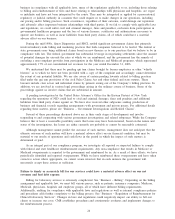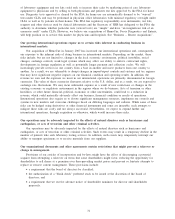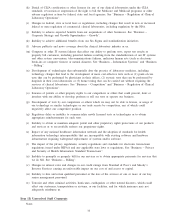Quest Diagnostics 2006 Annual Report Download - page 46
Download and view the complete annual report
Please find page 46 of the 2006 Quest Diagnostics annual report below. You can navigate through the pages in the report by either clicking on the pages listed below, or by using the keyword search tool below to find specific information within the annual report.
Item 1A. Risk Factors
Efforts by third party payers, including the government, to reduce utilization and pricing could have a
material adverse effect on our net revenues and profitability.
Government payers, such as Medicare and Medicaid, as well as private payers and larger employers have
taken steps and may continue to take steps to control the cost, utilization and delivery of healthcare services,
including clinical laboratory services. By law an adjustment to the Medicare national fee schedule for clinical
laboratory services based on the consumer price index cannot occur before January 1, 2009. Congressional budget
reconciliation efforts could result in further reductions in Medicare and/or Medicaid expenditures for laboratory
services in the future. In addition, by law CMS is required to conduct two demonstration projects of competitive
bidding for clinical laboratory services. If competitive bidding were implemented on a regional or national basis
for clinical laboratory testing, it could materially adversely affect the clinical laboratory testing industry and us.
In September 2003, the OIG published a proposed regulation that would authorize the OIG to exclude a provider
for submitting claims to Medicare that contain charges that are substantially in excess of the provider’s usual
charges. If this regulation is adopted as proposed, it could potentially reduce the amounts we bill and collect
from Medicare and other federal payers, affect the fees we charge to other payers, or subject us to penalties for
non-compliance, and could also be costly for us to administer. For a more detailed description of the
developments in government regulations, see “Business – Regulation of Reimbursement for Clinical Laboratory
Services”.
The healthcare industry has experienced a trend of consolidation among healthcare insurers, resulting in
fewer but larger insurers with significant bargaining power in negotiating fee arrangements with healthcare
providers, including clinical laboratories. These healthcare insurers, as well as independent physician associations,
demand that clinical laboratory service providers accept discounted fee structures, or assume all or a portion of
the financial risk associated with providing testing services to their members through capitated payment
arrangements. Historically, healthcare insurers, which had limited their network of laboratory service providers,
encouraged their members, and sometimes offered incentives, to utilize only contracted providers. In cases where
members choose to use a non-contracted provider due to service quality or convenience, the non-contracted
provider would be reimbursed at rates considered “reasonable and customary”. In addition, patients who use a
non-contracted provider may have a higher co-insurance responsibility, which may result in physicians referring
testing to contracted providers to minimize the expense to their patients. Contracted rates are generally lower than
“reasonable and customary” rates because of the potential for greater volume as a contracted provider. However,
a non-contracted laboratory service provider with quality and service preferred by physicians and patients to that
of contracted providers, could potentially realize greater profits than if it was a contracted provider, provided that
physicians and patients continue to have choice in selecting their provider. Physicians requiring testing for
patients are the primary referral source of our clinical laboratory testing volume, and often refer work to us as a
non-contracted provider. Recent experience indicates that at least one large healthcare insurer, UNH, is looking to
restrict or eliminate the choice of physicians, and in turn their patients, by threatening to impose financial
penalties on physicians for referring patients to non-contracted laboratory service providers. If this approach is
successful in influencing physicians to no longer use non-contracted laboratories, it could make it substantially
more difficult for a laboratory service provider to sufficiently differentiate itself based on quality and service in
order to profitably operate as a non-contracted provider, could lead to other healthcare insurers using similar
tactics, and could materially impact our financial condition, results of operations and cash flows. See
“Business – Recent Changes in Payer Relationships” and “Business – Payers and Customers – Healthcare
Insurers”.
We expect efforts to impose reduced reimbursements and more stringent cost controls by government and
other payers to continue. These efforts, as well as changes in payer mix, including an increase in the percentage
of patients covered by capitated payment arrangements, could negatively impact our net revenues. If we cannot
offset additional reductions in the payments we receive for our services by reducing costs, increasing test volume
and/or introducing new procedures, our net revenues and profitability could be materially adversely affected.
If we fail to comply with extensive laws and regulations, we could suffer fines and penalties or be required
to make significant changes to our operations.
We are subject to extensive and frequently changing federal, state and local laws and regulations. We
believe that, based on our experience with government settlements and public announcements by various
government officials, the federal government continues to strengthen its position on healthcare fraud. In addition,
legislative provisions relating to healthcare fraud and abuse give federal enforcement personnel substantially
increased funding, powers and remedies to pursue suspected fraud and abuse. While we seek to conduct our
25


